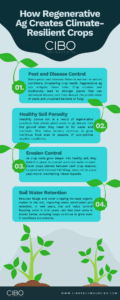CIBO Certified Crop Advisor Pathway:
How Regenerative Ag Creates Climate Resilience

Some pests and diseases thrive in warmer or wetter conditions, threatening crop health. Regenerative ag can mitigate these risks. Crop rotation and biodiversity lead to stronger plants that can withstand disease, and they disrupt the proliferation of pests and unwanted bacteria or fungi.
Healthily porous soil is a result of regenerative practices that allows plant roots to go deeper into the ground when they need to for water and nutrients. This helps farmers continue to grow nutritious food even in seasons of sub-optimal weather conditions.
As crop roots grow deeper into healthy soil, they hold it in place to prevent wind and water erosion. Cover crops planted between cash crop seasons, coupled with minimal fall tilling, keep soil in place year-round, maintaining robust topsoils.
Reduced tillage and cover cropping increase organic matter in the soil, improving water penetration and retention. In wet years, the soil helps control flooding, while in drier years, rain that does come is stored better, ensuring crops continue to grow even if conditions are extreme.
hbspt.forms.create({
region: “na1”,
portalId: “3920503”,
formId: “5008c046-6ac1-4af8-9f31-d26b56b6f3df”
});
Return to the pathway to build your knowledge of information about the certified crop advisor program.
Return to Pathway